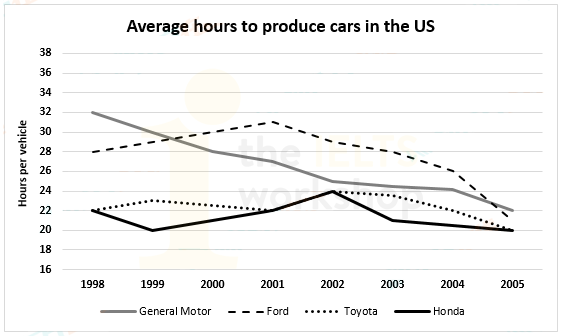5+ The graph below shows the average time spent by four car manufacturers to produce vehicles
The graph below shows the average time spent by four car manufacturers to produce vehicles at their US factories from 1998 to 2005. Summarise the information by selecting and reporting the main features, and make comparisons where relevant. Write at least 150 words hay nhất giúp bạn có thêm tài liệu tham khảo để viết bài luận bằng Tiếng Anh hay hơn.
- The graph below shows the average time spent by four car manufacturers to produce vehicles (mẫu 1)
- The graph below shows the average time spent by four car manufacturers to produce vehicles (mẫu 2)
- The graph below shows the average time spent by four car manufacturers to produce vehicles (mẫu 3)
- The graph below shows the average time spent by four car manufacturers to produce vehicles (mẫu 4)
- The graph below shows the average time spent by four car manufacturers to produce vehicles (mẫu 5)
- The graph below shows the average time spent by four car manufacturers to produce vehicles (mẫu 6)
5+ The graph below shows the average time spent by four car manufacturers to produce vehicles
Đề bài: The graph below shows the average time spent by four car manufacturers to produce vehicles at their US factories from 1998 to 2005. Summarise the information by selecting and reporting the main features, and make comparisons where relevant. Write at least 150 words
The graph below shows the average time spent by four car manufacturers to produce vehicles - mẫu 1
The provided line graph illustrates how much time on average 4 different automobile manufacturers spent producing vehicles at their US factories over a 7-year period, starting from 1998.
Overall, it is evident that all brands experienced downward trends in production time. Notably, it took Honda less time than other manufacturing companies to produce vehicles during the entire period.
In terms of General Motor, the average production time started at 32 hours in the first year, followed by a constant drop to finish at 22 hours after 7 years. Likewise, it took Ford 28 hours to produce vehicles in 1998, after which the hours rose gradually till the early 2000s, when it outstriped General Motor's average time to become the slowest automobile producer during the next 4 years. However, in 2005, the figure went down to below 22 hours, giving back the lead to General Motor.
Both Toyota and Honda initially spent 22 hours on average on car production. However, while the figure for Toyota slightly increased in the next year, that of Honda experienced an opposite trend, with approximately 23 and precisely 20 hours, respectively. Toyota's average hours went on to fluctuate before finishing at 20 in 2005. Meanwhile, the time Honda spent on car manufacturing saw a sharp increase reaching its peak at 24 hours in 2002, coinciding with Toyota's highest point. The figure then declined to 20 hours in the last year, paralleling Toyota's hours in the same period.
The graph below shows the average time spent by four car manufacturers to produce vehicles - mẫu 2
The line graph illustrates the average amount of time to produce new cars of 4 companies, namely General Motor, Ford, Toyota, and Honda at their factories in the US between 1998 and 2005. Overall, it can be seen that it became faster for these companies to produce new cars over the given period.
In 1998, General Motor spent about 32 hours on average manufacturing a new car, which was also the longest of all this year. In the next 7 years, there was a continuous downward trend in this number, reaching at roughly 22 hours. During this time, the figure for Ford surpassed General Motor in 1999, rising from nearly 28 hours to barely 31 hours in 2001. After that, it went down remarkably by almost 10 hours in the end.
On the other hand, the figures for Toyota and Honda were quite similar at 22 hours in the beginning. Both of them also witnessed a significant fluctuation in the following years. However, in the end, they both dropped to merely 20 hours for their car production.
The graph below shows the average time spent by four car manufacturers to produce vehicles - mẫu 3
The line graph illustrates the average number of hours required by four automobile manufacturers- General Motors, Ford, Toyota, and Honda-to produce vehicles at their factories in the United States from 1998 to 2005.
Overall, there was a noticeable decline in production time across all four manufacturers over the period. Honda consistently had the shortest production time, while Ford showed significant fluctuations, particularly in the early 2000s. By 2005, the production times of all manufacturers had converged to around 20-22 hours per vehicle.
General Motors began the period with the highest production time, taking approximately 32 hours to manufacture a vehicle in 1998. This time decreased steadily, ending at around 22 hours in 2005, showing consistent improvement. In contrast, Ford initially took 28 hours per vehicle in 1998. However, instead of improving, Ford's production time increased, peaking at 34 hours in 2001, making it the least efficient manufacturer during this period. After this peak, Ford made significant strides in reducing its production time, bringing it down to just under 22 hours by 2005, closely aligning with General Motors.
Toyota and Honda both started with a similar production time of around 22 hours per vehicle in 1998. Honda's production time dropped slightly to 20 hours by 1999, making it the most efficient manufacturer at that point. However, Honda's efficiency fluctuated, with production time rising sharply to 24 hours in 2002 before decreasing back to 20 hours by 2005. Toyota, on the other hand, saw a slight increase in production time to 23 hours in 1999 but maintained a relatively stable production time, fluctuating only slightly before finally reducing to 20 hours by 2005. Both companies demonstrated a trend towards greater efficiency, with their production times converging by the end of the period.
The graph below shows the average time spent by four car manufacturers to produce vehicles - mẫu 4
The graph provides information about the average time taken by four major car corporations to manufacture vehicles at their American factories over the course of seven years.
Overall, the average amount of time spent by the four different brands experienced fluctuating decreases during the course of the period. Additionally, General Motors went through the best improvement regarding production time.
The American automakers, General Motors and Ford, began the period with longer manufacturing schedules - 32 and 28 hours per vehicle, respectively. Both demonstrated a declining tendency in the amount of time needed to produce an automobile, with a more noticeable decrease at General Motors. Ford reduced its production time to slightly above 20 hours per vehicle by 2005, while General Motors had almost halved its time to about 22 hours.
Japanese producers Toyota and Honda started with considerably lower manufacturing times. Toyota began at slightly below 22 hours per vehicle in 1998, and by 2005, it diminished the time to approximately 20 hours. Honda started and ended similarly to Toyota, beginning at above 22 hours and further increasing its effectiveness to 20 hours by 2005.
The graph below shows the average time spent by four car manufacturers to produce vehicles - mẫu 5
The line graph compares the changes in the average hours needed to manufacture a vehicle by four companies – General Motor, Ford, Toyota and Honda – at their producing sites in the US between 1998 and 2005.
Overall, while the two Japanese car companies produced vehicles more quickly in general, the two US manufacturers had narrowed the gap remarkably.
It is clear that GM had successfully improved their productivity, with the average time reducing from 32 hours per vehicle to 22 hours during the given period, although the figure remained the highest among the four producers in the first two years. In Ford’s factories, there was an initial increase in the figure from 28 hours to over 30 until 2001, after which the factories started to achieve higher efficiency. By 2005, the time needed to produce a car had descended to just 21 hours.
In terms of Toyota and Honda, both manufacturers kept their average production time at a low level between 20 and 24 hours per car, maintaining higher productivity than the other two competitors. Despite wild fluctuations throughout the whole period, factories of both Toyota and Honda managed to slightly reduce the average time.
The graph below shows the average time spent by four car manufacturers to produce vehicles - mẫu 6
The line graph illustrates the average time spent by four car manufacturers - General Motors, Ford, Toyota, and Honda - in producing vehicles at their factories in the United States from 1998 to 2005.
Overall, the time required for car production at all four companies showed a downward trend, with Toyota and Honda achieving the lowest production hours by the end of the period. Meanwhile, American manufacturers General Motors and Ford started with higher production times but managed to reduce them significantly.
In 1998, General Motors had the longest production time at approximately 32 hours, followed closely by Ford with around 30 hours. However, both companies saw a steady decline over the period, with Ford experiencing a particularly sharp reduction from 2002 onwards, reaching about 22 hours by 2005. General Motors, while maintaining a consistent drop, ended at slightly above 20 hours.
Toyota and Honda, on the other hand, maintained lower production times throughout. Starting at around 22 hours in 1998, Toyota gradually decreased its hours and eventually reached roughly 19 hours in 2005, the lowest among the four. Honda displayed a similar pattern, reducing its production time from about 21 hours in 1998 to just under 20 hours in 2005.
Xem thêm các bài luận Tiếng Anh hay khác:
Đã có app VietJack trên điện thoại, giải bài tập SGK, SBT Soạn văn, Văn mẫu, Thi online, Bài giảng....miễn phí. Tải ngay ứng dụng trên Android và iOS.
Theo dõi chúng tôi miễn phí trên mạng xã hội facebook và youtube:Nếu thấy hay, hãy động viên và chia sẻ nhé! Các bình luận không phù hợp với nội quy bình luận trang web sẽ bị cấm bình luận vĩnh viễn.
- Đề thi lớp 1 (các môn học)
- Đề thi lớp 2 (các môn học)
- Đề thi lớp 3 (các môn học)
- Đề thi lớp 4 (các môn học)
- Đề thi lớp 5 (các môn học)
- Đề thi lớp 6 (các môn học)
- Đề thi lớp 7 (các môn học)
- Đề thi lớp 8 (các môn học)
- Đề thi lớp 9 (các môn học)
- Đề thi lớp 10 (các môn học)
- Đề thi lớp 11 (các môn học)
- Đề thi lớp 12 (các môn học)
- Giáo án lớp 1 (các môn học)
- Giáo án lớp 2 (các môn học)
- Giáo án lớp 3 (các môn học)
- Giáo án lớp 4 (các môn học)
- Giáo án lớp 5 (các môn học)
- Giáo án lớp 6 (các môn học)
- Giáo án lớp 7 (các môn học)
- Giáo án lớp 8 (các môn học)
- Giáo án lớp 9 (các môn học)
- Giáo án lớp 10 (các môn học)
- Giáo án lớp 11 (các môn học)
- Giáo án lớp 12 (các môn học)






 Giải bài tập SGK & SBT
Giải bài tập SGK & SBT
 Tài liệu giáo viên
Tài liệu giáo viên
 Sách
Sách
 Khóa học
Khóa học
 Thi online
Thi online
 Hỏi đáp
Hỏi đáp

